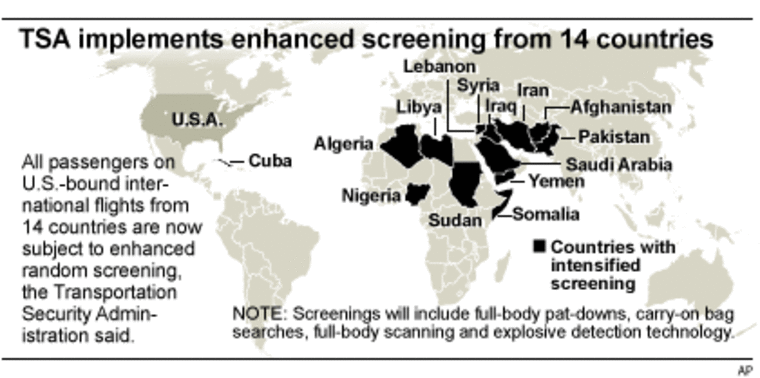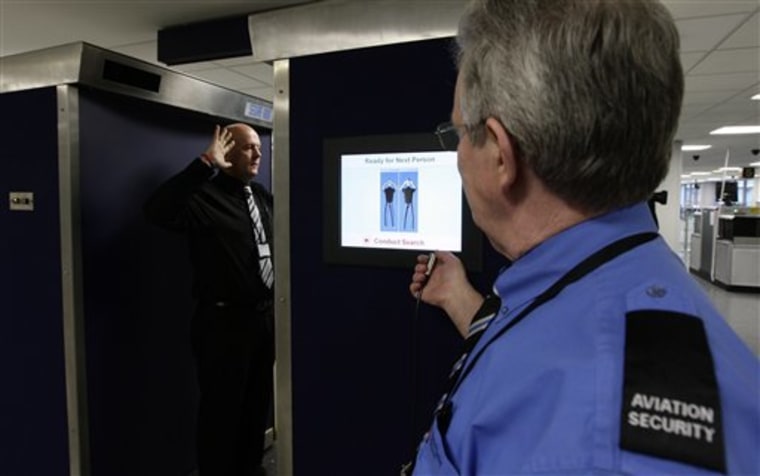A lot of travelers and privacy rights groups have their shorts in a bunch about airport body scanners that can look right through your clothing.
Last week, in response to the botched Christmas Day airline bombing attempt, President Barack Obama ordered reforms in how the intelligence community gathers and shares information. At the same time, Homeland Security Secretary Janet Napolitano announced plans for the Transportation Security Administration to step up the purchase, installation, and general use of full-body scanners at the nation’s airports.
The TSA already has 40 scanners in operation at 19 U.S. airports. (You can see the locations here). Six machines are being used for primary screening at six airports, and 34 other machines at 13 airports, are used for secondary screening and as an alternative to pat downs. An additional 300 units, which can cost up to $170,000 a piece, are scheduled to be rolled out in U.S. airports by the end of this year.
These machines use a variety of technologies to scan for prohibited and dangerous items that may be concealed on a body. In doing so, the scanners peer through a person’s clothing and can reveal not just weapons and plastic or chemical explosives, but very clear and somewhat graphic images of the size and shape of body parts.
It’s the graphic images created by these scanners, and worries about the unauthorized and inappropriate places the scanned images might end up, that has groups such as the ACLU worried. “These technologies are way too invasive,” says Chris Calabrese, on the ACLU’s Legislative Council. “For some people it’s a religious issue. For most people, it’s an issue of modesty. They don’t want some TSA employee ogling them, and they don’t feel it should be a cost of air travel.”
For its part, the TSA is telling travelers there’s really no need to be concerned. According to TSA spokesperson Greg Soule, on it Web site, in videos, and in official documents such as the Privacy Impact Assessment (PIA) for TSA Whole Body Imaging, the agency explains that the body scanner machines will have no ability to “save, transmit, or print” images, and that the scanner technology is part of a “multi-layered security strategy to stay ahead of evolving threats.” But the ACLU ‘s Calabrese says, “There are a large number of both legal and policy reasons why the government would feel it would have to save images; no matter what they’re saying now.”
Other groups, such as the Washington-based Electronic Privacy Information Center (EPIC), join the ACLU in sounding an alarm. “They say, ‘don’t worry,’ but they completely don’t talk about the fact that the scanners are essentially digital cameras designed to peer through clothes,” says EPIC Executive Director Marc Rotenberg.
Through a Freedom of Information Act (FOIA) lawsuit, EPIC obtained the TSA’s technical specifications and vendor contracts for the body scanners being purchased by the TSA. Two-hundred and fifty pages of the documents are now posted on the EPIC web site. Rotenberg says these documents prove that — despite what the TSA is saying about privacy and security controls — vendors are being asked to deliver machines that can, among other things, save, record, and transfer images. “The specifications talk about saving images for training and for legal evidence. It just doesn’t make sense. EPIC feels that further deployment of the scanner devices should be suspended until the privacy and security problems brought up by these documents have been resolved.”
For now, travelers can just say “No” to scanners
Unless EPIC and other organizations convince legislators to suspend or delay use of the scanners during upcoming Homeland Security and related hearings, there’s a fair chance that someday soon a TSO (Transportation Security Officer) at an airport will ask you to step into one of these body scanners.
Right now, you don’t have to. Especially if you’re like Wanderlust and Lipstick founder Beth Whitman and are “fundamentally opposed to the naked factor.” The TSA’s Greg Soule says, “At this point, the technology is 100 percent optional. However, if a passenger chooses not to go through, they will get a commensurate level of screening to include a full body pat down.”

But don’t assume everyone will say no to body scanners. “Pat downs seem slower, more invasive, and less guaranteed to detect objects than body scanners do,” says Jeremy Hoffman, a software engineer in Palo Alto, Calif. He thinks “privacy concerns are overblown” and agrees with the 78 percent of respondents in a recent TripAdvisor.com poll on body scanners who said they thought the machines “would enhance security”, and the 88 percent who said they were more comfortable with a full-body scan than with a full-body pat down.
“If it means I don’t have to wait 10 or 15 minutes for a female TSO to be available for an invasive pat down; sign me up,” says Ellen Bentley, a diagnostic plant pathologist who must always wear loose clothing to the airport so she can show security personnel the scar from her knee replacement.
And then there’s the American Association for Nude Recreation. AANR Executive Director Erich Schuttauf says there’s nothing wrong with full-body scanners at the airports if they can help insure that passengers only bring aboard “what nature gave them.” In fact, says Schuttauf, if travelers just think of the screening process “as a virtual skinny dip,” then “everyone wins in the name of better air travel security.”
Harriet Baskas is a frequent contributor to msnbc.com, authors the and is a columnist for USATODAY.com. You can follow her on .
